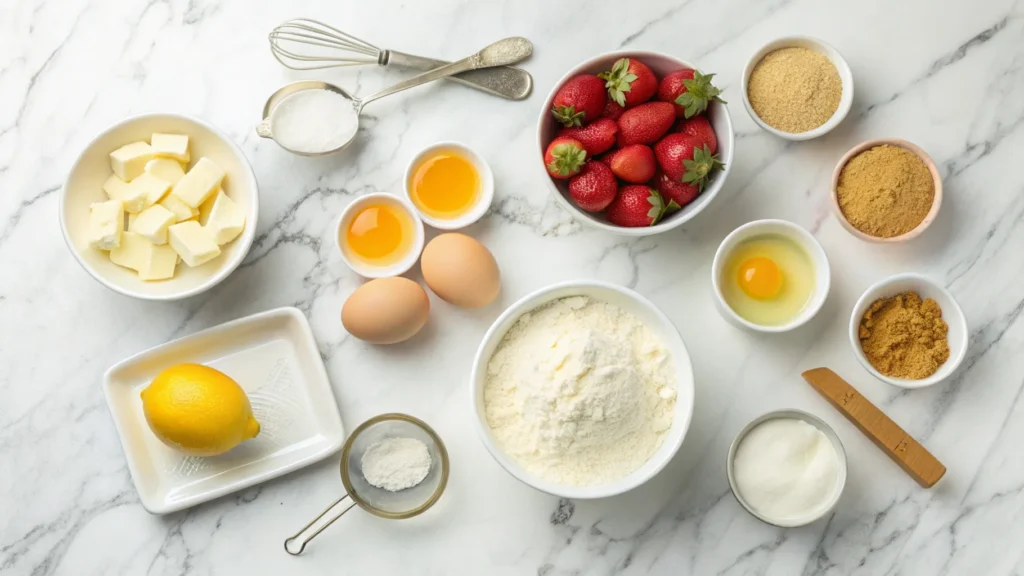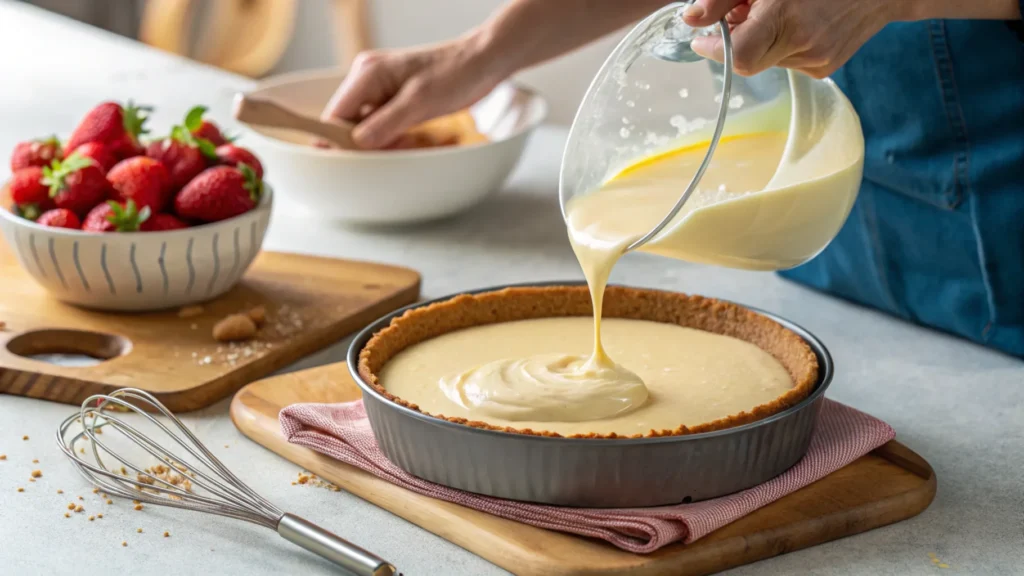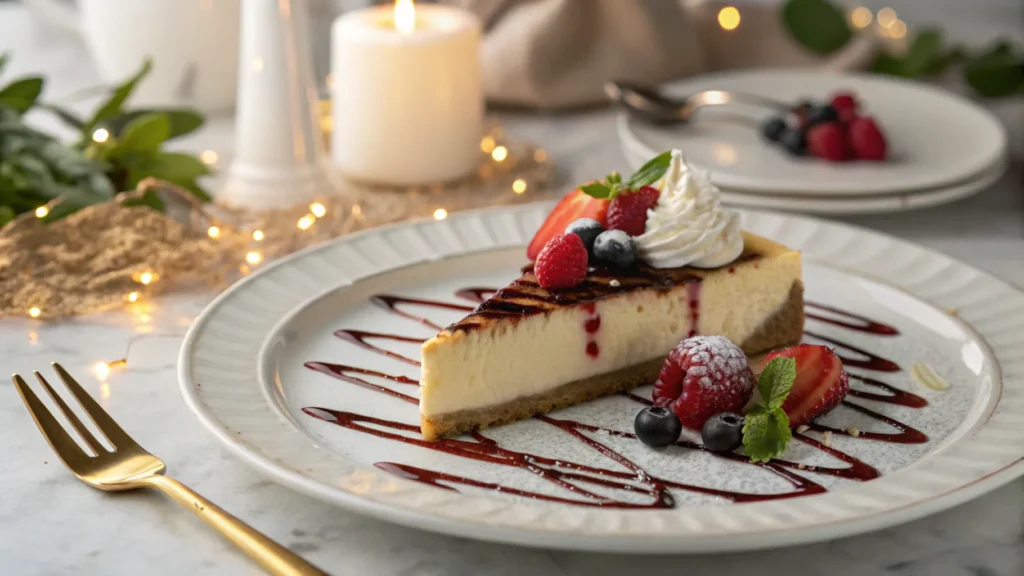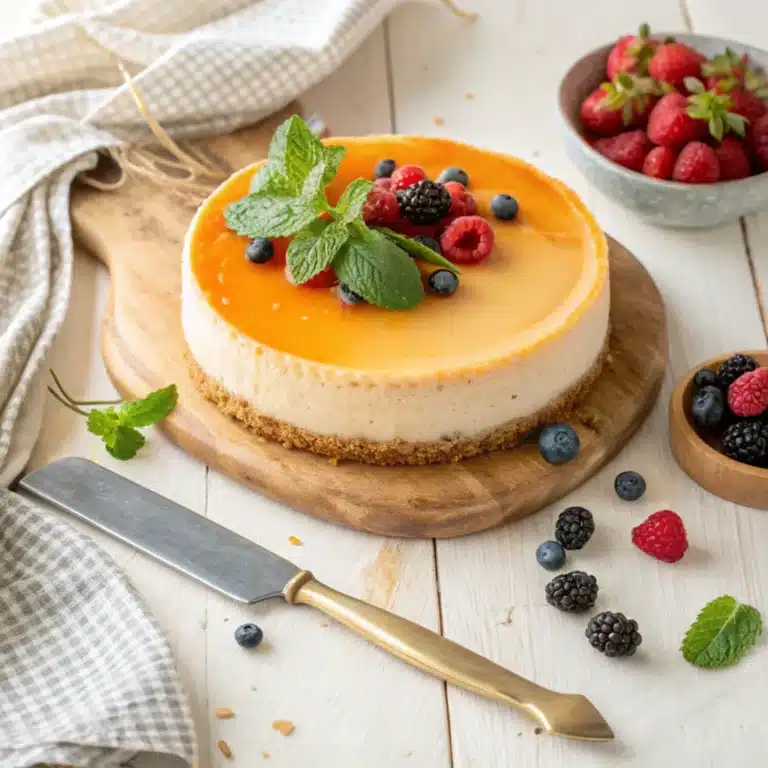French cheesecake captures the essence of light and creamy desserts, offering a refined twist on a classic favorite. With its subtle sweetness, airy texture, and touch of French elegance, it stands out from heavier, richer versions. Whether made with fromage blanc or traditional cream cheese, it provides a unique flavor that’s sure to leave a lasting impression. In this article, we’ll explore the heart of French cheesecake, its key ingredients, variations, and a step-by-step guide to making it at home. By the end, you’ll be ready to create this elegant dessert for any occasion.
Introduction to French Cheesecake
What Defines a French Cheesecake?
Unlike the heavy, dense New York-style cheesecake, French cheesecake is known for its light and fluffy texture. This dessert often uses fromage blanc, a soft French cheese with a tangy, delicate flavor. The filling is less sweet, allowing the natural creaminess to shine. It’s paired with a thin crust, often made from crushed biscuits or pastry, to complement the smooth filling without overwhelming it.
Another hallmark of French cheesecake is its simplicity. The recipe typically requires fewer ingredients, focusing on quality rather than quantity. This minimalist approach creates a dessert that feels both indulgent and understated, perfect for those who enjoy desserts that don’t feel overly rich.
How French Cheesecake Differs from Other Types
So, what sets French cheesecake apart? The primary difference lies in the texture and flavor. French versions are often baked gently or even served as no-bake options to maintain their airy quality. The crust, while present, takes a backseat to the creamy filling, unlike American cheesecakes, where the crust often plays a more prominent role.
Additionally, French cheesecake embraces subtle flavors, using natural ingredients like vanilla or citrus zest to Improve the cheese’s tanginess. It’s less sugary, making it a favorite for those who prefer lighter desserts. Whether you’re a fan of traditional cheesecakes or new to this style, French cheesecake offers a delightful alternative that’s hard to resist.
Key Ingredients in French Cheesecake
The Importance of Fromage Blanc or Cream Cheese
The heart of any French cheesecake lies in its choice of cheese. Traditional recipes often use fromage blanc, a soft French cheese with a tangy yet subtle flavor. Its light texture makes the cheesecake airy, setting it apart from its denser counterparts. If fromage blanc isn’t available, cream cheese is a reliable substitute. To mimic the tang of fromage blanc, some bakers blend cream cheese with sour cream or yogurt.
Sugar is used sparingly in French cheesecake, ensuring the natural flavors of the cheese remain the focus. This balance of creaminess and slight sweetness creates a dessert that feels indulgent yet light.
Other Essential Ingredients for Authentic French Cheesecake
Crafting the perfect French cheesecake involves just a few key ingredients. Eggs are crucial for achieving a silky, custard-like texture. Vanilla extract or fresh vanilla beans add a layer of warmth. At the same time, a touch of lemon zest provides brightness that balances the richness of the filling.
The crust is typically made from crushed biscuits or butter cookies mixed with melted butter. This forms a thin, slightly crumbly base that complements the creamy filling without overshadowing it.
Ingredients:
- 1 cup fromage blanc or cream cheese
- 1/2 cup granulated sugar
- 2 large eggs
- 1 teaspoon pure vanilla extract
- Zest of 1 lemon
- 1 cup crushed biscuits (butter cookies or graham crackers)
- 4 tablespoons melted butter

Optional Additions for Flavor Variations
Consider adding fresh berries or a drizzle of fruit compote to the filling for a more personalized touch. Chocolate shavings or a caramel glaze can transform the dessert into a more decadent version. These simple tweaks allow you to tailor the cheesecake to suit any preference or occasion.
Popular Variations of French Cheesecake
Classic French Cheesecake with Fromage Blanc
The classic French cheesecake is a celebration of simplicity. It features fromage blanc as the star ingredient, paired with a thin biscuit crust and lightly sweetened filling. The cheesecake is baked gently to achieve a soft, custard-like texture. To finish, it’s often topped with a glaze of apricot preserves, adding a subtle sweetness and an elegant shine.
French Cheesecake with a Biscuit Crust
A biscuit-crusted French cheesecake is a popular option for those who love a bit more texture. The crust is made from crushed butter cookies or graham crackers mixed with melted butter for a crisp yet delicate base. Some recipes incorporate a pinch of cinnamon or nutmeg for added depth, making this version a favorite for festive occasions.
Flavored French Cheesecakes: Lemon, Berry, and More
Flavored French cheesecakes bring variety to this classic dessert. Lemon variations featuring lemon zest and juice add a refreshing tang that pairs beautifully with the creamy filling. Berry options, such as raspberry or blueberry, introduce a vibrant twist. Swirling a berry puree into the filling creates a marbled effect that’s both visually stunning and delicious.
These variations highlight the versatility of French cheesecake, ensuring there’s a version for every palate and occasion. Whether you prefer traditional or experimental, this dessert never disappoints.
Step-by-Step Guide to Making French Cheesecake
Preparing the Crust and Filling
Making a French cheesecake starts with a simple yet flavorful crust. To prepare the base, combine 1 cup of crushed biscuits, such as butter cookies or graham crackers, with 4 tablespoons of melted butter. Mix until the crumbs are evenly coated, then press the mixture into the bottom of a springform pan. Chill in the fridge for 15 minutes to firm up while you prepare the filling.
For the filling, beat 1 cup of fromage blanc (or cream cheese if unavailable) with 1/2 cup granulated sugar until smooth. Add 2 large eggs, one at a time, mixing thoroughly after each addition. Stir in 1 teaspoon of vanilla extract and the zest of 1 lemon for a subtle hint of freshness. Once combined, pour the filling over the chilled crust.

Baking and Cooling Tips for Perfect Texture
Preheat your oven to 325°F (165°C) and bake the cheesecake for 45-50 minutes, or until the center is slightly jiggly. To prevent cracks, place a pan of hot water on the bottom rack of the oven to create steam. Once baked, turn off the oven and let the cheesecake cool inside for 30 minutes. Then, transfer it to a wire rack to cool completely before refrigerating for at least 4 hours or overnight.
For more baking tips, check out the Ultimate Guide to Cream Cheese Filling Recipes, which includes additional techniques for perfecting cheesecake.
Decorating and Serving Suggestions
For a classic touch, decorate your French cheesecake with a thin glaze of apricot preserves. Alternatively, garnish with fresh berries, powdered sugar dusting, or a chocolate sauce drizzle. Serve chilled with a cup of French press coffee or a refreshing herbal tea for a delightful pairing.
Healthier Alternatives and Dietary Adjustments
Low-Sugar and Low-Fat Options
If you want to enjoy French cheesecake without the extra calories, there are easy substitutions to lighten it up. Replace half the sugar with a natural sweetener like stevia or erythritol. For the crust, use whole-grain biscuits to add fiber and nutrients. Swap full-fat cream cheese with a lower-fat version or a combination of light cream cheese and Greek yogurt for the filling. These adjustments create a lighter version that’s still rich in flavor.
Substitutions for Vegan and Gluten-Free Diets
To make a vegan French cheesecake, replace cream cheese with a plant-based alternative, such as cashew or vegan cream cheese. Use flaxseed mixed with water as an egg substitute, and replace butter with coconut oil in the crust. For a gluten-free option, use gluten-free biscuits for the crust while keeping the filling recipe the same.
These simple changes allow everyone, regardless of dietary preferences, to enjoy the light and creamy goodness of French cheesecake.
Why French Cheesecake Is a Timeless Favorite
A Dessert Rooted in Elegance
French cheesecake is beloved for its delicate flavor and airy texture, making it a favorite for those who appreciate light yet satisfying desserts. Its subtle sweetness and creamy filling strike a perfect balance that appeals to various palates. The recipe’s simplicity and the option to add creative toppings ensure that it remains a timeless choice for any occasion.
Versatile and Perfect for Any Occasion
One reason French cheesecake has endured is its versatility. It’s elegant enough for formal gatherings yet simple enough for casual dinners. Whether topped with fresh fruit, a caramel drizzle, or served plain, it fits effortlessly into any menu. This adaptability secures its popularity across generations and different culinary styles.
French cheesecake’s unique combination of lightness and richness makes it a dessert that satisfies without overwhelming. Whether indulging in a classic slice or experimenting with flavored variations, this dessert never fails to impress.
Pairing Ideas for French Cheesecake
Beverages That Complement French Cheesecake
The delicate flavors of French cheesecake pair beautifully with various beverages, making it a versatile dessert for any occasion. Consider serving it with a freshly brewed cup of Earl Grey tea or a light-roasted coffee for a warm option. These drinks highlight the creamy texture of the cheesecake and balance its subtle sweetness.
On the other hand, for something more refreshing, a sparkling white wine or a crisp rosé makes an excellent pairing. In particular, the bubbles and acidity cut through the richness of the dessert, creating a balanced and delightful experience. Moreover, a chilled glass of lemonade with a hint of mint works perfectly if you prefer non-alcoholic options. Adding a touch of mint complements fruity cheesecake variations, making it even more refreshing.
Ultimately, whether you choose a warm or cold beverage, these pairings Promote the flavors of French cheesecake and Improve the overall dining experience.
Toppings and Garnishes to Try
Adding thoughtful toppings can Promote your French cheesecake presentation and flavor. A dollop of whipped cream with a sprinkle of crushed pistachios offers a touch of elegance. Alternatively, a thin layer of fruit preserves, such as raspberry or apricot, adds a hint of tartness that contrasts beautifully with the creamy filling.
For a touch of indulgence, drizzle chocolate or caramel sauce over the cheesecake and garnish with fresh berries. These simple Improvements make the dessert visually appealing and provide extra layers of flavor.

FAQs
What Is the Best Cheese for French Cheesecake?
The best cheese for crafting an authentic French cheesecake is fromage blanc. This traditional French ingredient gives the dessert its signature light and tangy flavor. Cream cheese is an excellent substitute if you can’t find fromage blanc. Consider blending cream cheese with sour cream or Greek yogurt to achieve a similar texture and slight tanginess for a closer match.
Can French Cheesecake Be Made Without an Oven?
Yes, you can make a no-bake version of French cheesecake! To do so, skip the eggs and bake time and instead create a filling using cream cheese, sugar, vanilla, and whipped cream. The mixture is spread over a prepared biscuit crust and chilled for several hours until firm. While it won’t have the same texture as the baked version, it’s easy to enjoy this dessert without turning on the oven.
How Should French Cheesecake Be Stored?
Store your French cheesecake in an airtight container in the refrigerator to keep it fresh. It will stay delicious for up to five days. If you need to store it longer, freeze individual slices wrapped tightly in plastic and foil. Thaw in the refrigerator overnight before serving.
The Timeless Appeal of French Cheesecake
Why It Stands the Test of Time
French cheesecake has remained a favorite for generations because of its perfect balance of simplicity and sophistication. Unlike heavier desserts, its airy texture and mild sweetness make it an ideal choice for any occasion. Combining high-quality ingredients and minimalist preparation makes the natural flavors shine, appealing to traditionalists and those seeking modern twists.
This timeless dessert reflects French culinary values, where subtlety and attention to detail take center stage. It’s a dessert that brings people together, offering comfort and elegance in every bite.
Adaptable for Every Preference
Another reason for French cheesecake’s lasting popularity is its versatility. Whether you prefer it plain, with a classic biscuit crust, or Improved by fresh fruit or chocolate, it adapts effortlessly to personal tastes. Home bakers love its simplicity, while chefs appreciate its potential for creative presentation.
Whether served at a family gathering, a formal dinner, or as a treat for yourself, French cheesecake never fails to impress. It’s a dessert that captures the essence of indulgence without being overly complicated, making it a timeless classic in the world of sweets.

